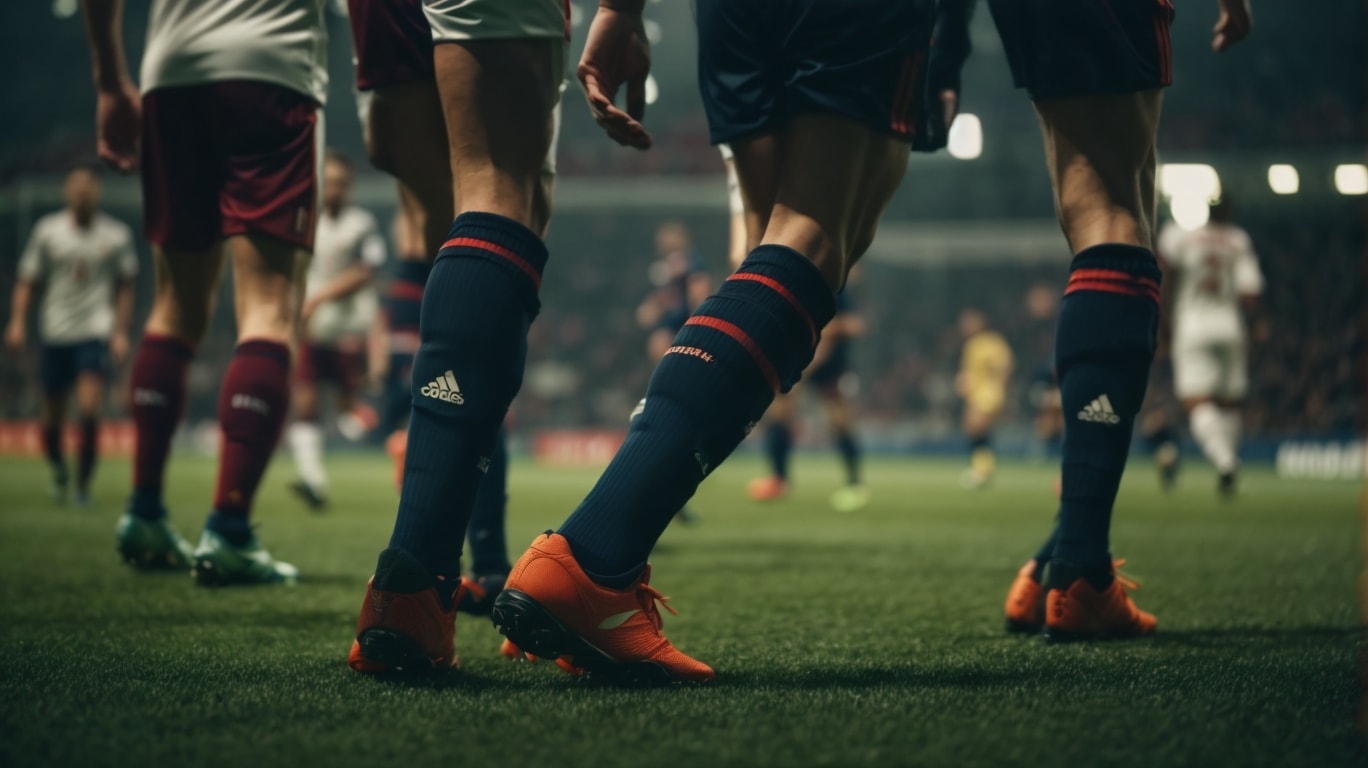Soccer, also known as football in many parts of the world, is a sport that has captivated millions of fans and players alike. From the strategies and tactics on the field to the various pieces of equipment and attire, there is much to explore and understand about this beloved game. One element of soccer attire that often catches the eye is the long socks worn by players. But why do soccer players wear long socks? In this article, we will delve into the reasons behind this seemingly simple yet intriguing aspect of the game.
Understanding the Basics of Soccer Attire
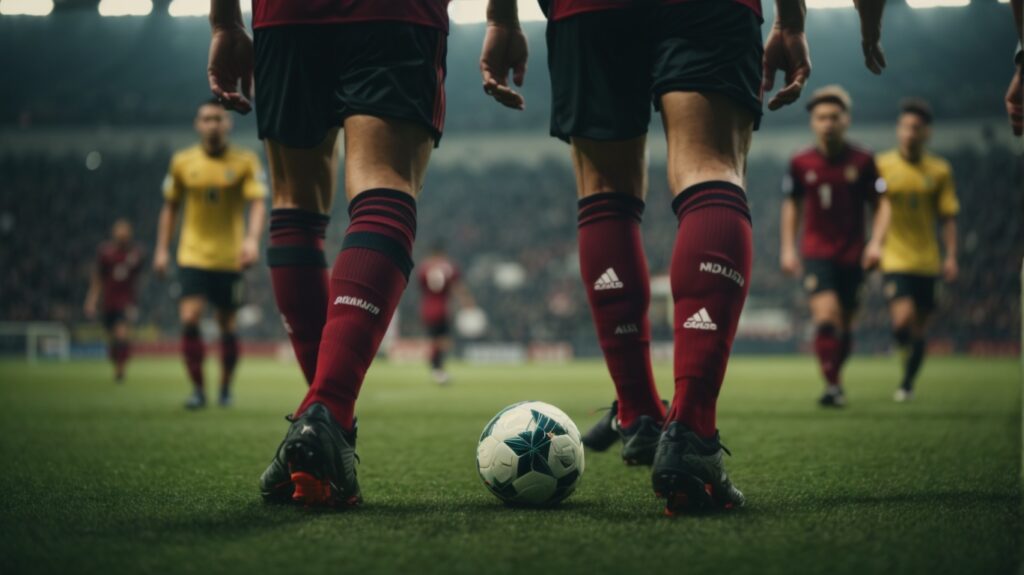
Before we delve into the specifics of soccer socks, it is important to have a clear understanding of the basic attire worn by soccer players. Soccer players typically wear a jersey or shirt, shorts, cleats, shin guards, and socks. These components serve various purposes, including providing comfort, enhancing performance, and protecting against injuries.
When it comes to soccer attire, every piece has its own significance. The jersey or shirt, for example, not only represents the player’s team but also allows for easy identification on the field. The shorts provide freedom of movement and allow players to run, kick, and maneuver with agility. Cleats, with their specialized studs or blades, offer traction and stability on the grass or turf, enabling players to make quick turns and sudden stops.
However, one component that often goes unnoticed is the soccer sock. While it may seem insignificant compared to other pieces of attire, soccer socks actually play a crucial role in the game. Soccer socks are designed to cover the entire calf and can be made of various materials such as cotton, polyester, or a blend of both. The length of the socks is what distinguishes them from regular everyday socks, as they often extend above the knees.
The Role of Socks in Soccer
One of the main reasons soccer players wear long socks is to hold their shin guards in place. Shin guards are essential for protecting the lower legs from injuries caused by kicks, collisions, or tackles. By wearing long socks, players can secure their shin guards in a comfortable position and prevent them from slipping or moving during the game.
Moreover, soccer socks also provide a layer of protection against friction and abrasion. As players constantly move on the field, their feet rub against the inside of their cleats. The socks act as a barrier between the foot and the shoe, reducing the risk of blisters and discomfort. Additionally, the materials used in soccer socks are often moisture-wicking, helping to keep the feet dry and preventing the accumulation of sweat, which can lead to discomfort and odor.
Different Types of Soccer Socks
There are different types of soccer socks available on the market, each offering its own unique features and benefits. Some socks are designed with extra padding in specific areas, such as the heel or toe, to provide additional cushioning and support. This can be particularly beneficial for players who engage in high-impact activities or have a history of foot injuries.
Others may have compression zones to improve blood circulation and reduce muscle fatigue during play. These compression socks apply gentle pressure to the muscles, promoting better oxygen flow and reducing the buildup of lactic acid, which can cause muscle soreness. This type of sock is often favored by professional soccer players who need to maintain optimum performance throughout the game.
Additionally, soccer socks come in various colors and designs, allowing teams to showcase their identity and create a sense of unity. Some teams even opt for custom-made socks with their logo or insignia, further emphasizing their unique style and brand. This not only enhances team spirit but also adds an element of visual appeal to the game.
In conclusion, while soccer socks may seem like a small and insignificant part of a player’s attire, they serve multiple purposes and play a crucial role in the game. From holding shin guards in place to providing protection, comfort, and style, soccer socks are an essential component of a soccer player’s gear.
The Historical Evolution of Long Socks in Soccer
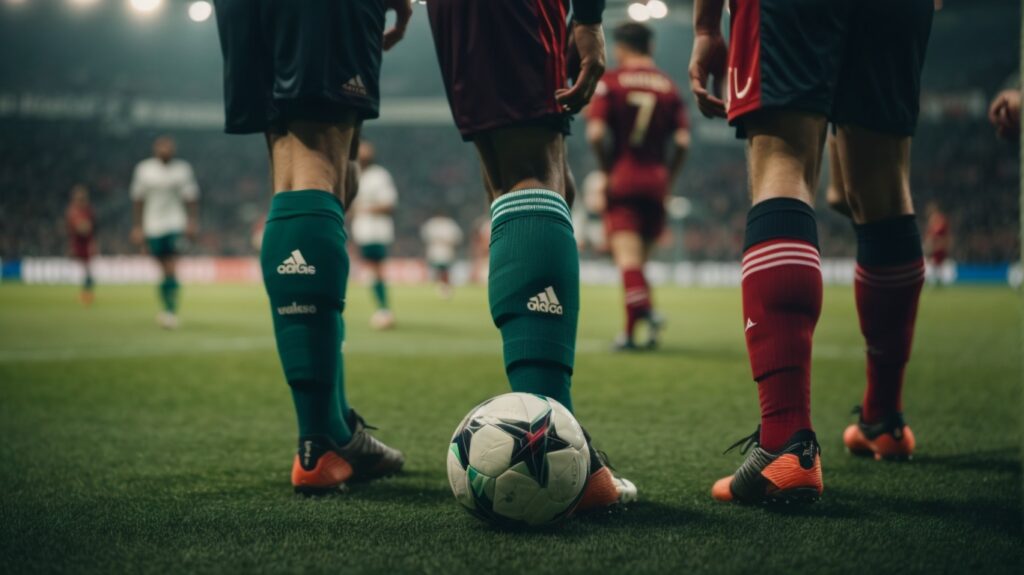
To understand the significance of long socks in soccer, it is essential to explore their historical evolution and how they have become a staple in the game today.
Early Uses of Long Socks in Soccer
The tradition of wearing long socks in soccer dates back to the early days of the sport. In the late 19th and early 20th centuries, players used woolen stockings to keep their legs warm during matches played in colder climates. These long socks not only provided insulation but also added an extra layer of protection against rough tackles and scrapes.
Furthermore, in the era when soccer was played predominantly on natural grass pitches, long socks offered an added advantage. They provided a barrier between the player’s skin and the rough terrain, reducing the risk of cuts, abrasions, and irritations.
As the popularity of soccer grew, so did the need for standardized uniforms. Long socks became an integral part of the soccer attire, not only for their practical benefits but also for the sense of unity and identity they brought to the teams.
During this early period, long socks were often plain and unadorned, serving a purely functional purpose. However, as the sport continued to evolve, so did the aesthetics of the game.
Modern Adaptations and Changes
As the sport of soccer evolved over the years, so did the materials and technology used in the production of long socks. Woolen stockings gave way to synthetic fabrics that were more lightweight, breathable, and durable.
With the introduction of synthetic materials, long socks became more comfortable and functional for players. They provided better moisture-wicking properties, keeping the players’ legs dry and preventing discomfort caused by sweat accumulation.
In addition to technological advancements, fashion trends also played a role in the evolution of long socks in soccer. As the game became more popular and professional, players and teams sought ways to stand out. Long socks became an avenue for self-expression, with teams incorporating their colors and patterns into their uniforms.
Teams started experimenting with different designs, incorporating stripes, chevrons, and even team logos into their long socks. This not only added a visual appeal to the players’ attire but also helped fans identify their favorite teams on the field.
As the sport of soccer became a global phenomenon, long socks also became a canvas for cultural representation. National teams started incorporating traditional patterns and symbols into their long socks, showcasing their heritage and creating a sense of pride.
Today, long socks have become an iconic part of soccer culture. Players at all levels of the game don these socks as a symbol of tradition, unity, and personal style. Whether it’s the classic black-and-white stripes of a referee’s socks or the vibrant colors and patterns of a player’s socks, these garments continue to be an essential component of the beautiful game.
Practical Reasons for Wearing Long Socks in Soccer
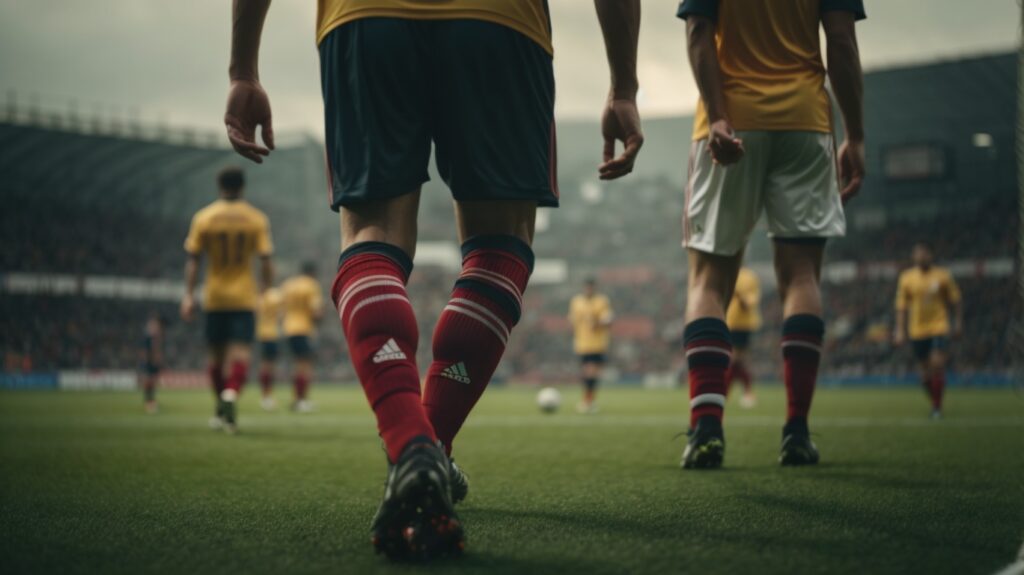
While the historical and aesthetic aspects of long socks in soccer are interesting, practical reasons play a significant role in their continued use today.
Protection Against Injuries
Soccer is known for its physicality, and players are exposed to various hazards on the field. The long socks act as a barrier, reducing the chances of cuts, grazes, and turf burns. Furthermore, the compression and padding provided by some socks can offer an extra layer of protection for the calf and shin area.
Imagine a player sprinting down the field, maneuvering through a crowd of opponents. Suddenly, an opponent’s cleat accidentally grazes the player’s leg. Without the long socks, this grazing motion could result in a painful cut or scrape. However, with the protective barrier of the long socks, the player’s skin remains unharmed, allowing them to continue playing without interruption.
Furthermore, during intense tackles or challenging aerial duels, players often find themselves landing on the ground forcefully. In such situations, the long socks provide an additional layer of cushioning, reducing the impact on the calf and shin area. This padding can help prevent injuries such as bone bruises or contusions, allowing players to stay on the field for longer periods.
Enhancing Performance
Long socks can also have a positive impact on a player’s performance. The compression fit offered by some socks can help improve blood circulation, reducing muscle fatigue and providing a supportive feel to the legs during extended periods of play.
When players engage in intense physical activity, their muscles require an adequate supply of oxygen and nutrients to perform optimally. The compression fit of long socks helps promote blood flow, ensuring that the muscles receive the necessary resources efficiently. This improved circulation can delay the onset of muscle fatigue, allowing players to maintain their agility and speed throughout the game.
Additionally, the snug fit of long socks can help keep the muscles warm, which is crucial for optimum performance. Warm muscles are more flexible and less prone to strain or injury, allowing players to showcase their skills throughout the game. With the added warmth and support from long socks, players can confidently execute quick turns, explosive sprints, and precise movements without the fear of muscle strains or pulls.
Compliance with Rules and Regulations
Soccer is known for its strict adherence to rules and regulations, and the length of socks is no exception. The governing bodies of the sport, such as FIFA, have specific guidelines regarding the length of socks that players must adhere to. By wearing long socks, players ensure compliance with these regulations and avoid penalties or disciplinary actions.
Imagine a player stepping onto the field for an important match, only to realize that their socks are too short according to the regulations. In such a scenario, the player would face disciplinary action, potentially leading to a penalty for their team. By wearing long socks, players eliminate this unnecessary risk and focus solely on their performance.
Moreover, the uniformity in appearance that long socks provide contributes to the overall professionalism and aesthetic appeal of the game. When all players on a team wear long socks, it creates a sense of unity and cohesion, reflecting a well-organized and disciplined team.
Psychological and Aesthetic Reasons for Long Socks
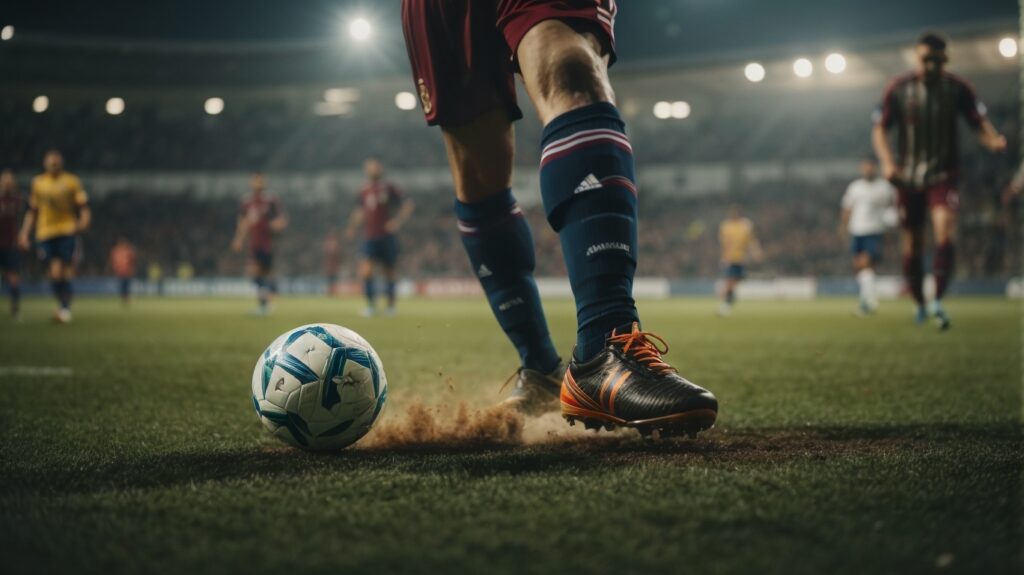
While practical considerations are at the forefront of wearing long socks, there are also psychological and aesthetic factors that come into play.
Team Identity and Uniformity
In team sports like soccer, a sense of unity and identity is crucial. Long socks, especially when customized with team colors or logos, contribute to creating a cohesive and professional appearance. By wearing matching socks, players not only showcase their affiliation but also foster a sense of camaraderie among teammates.
Psychological Boost and Confidence
As in any sport, the mental aspect of soccer plays a vital role in a player’s performance. For some players, wearing long socks can provide a psychological boost and instill a sense of confidence. The feeling of being fully kitted out in the complete soccer attire, including long socks, can help players feel mentally prepared and ready to tackle any challenges that come their way.
Controversies and Debates Around Soccer Socks
While the majority of soccer players wear long socks without question, there have been some controversies and debates surrounding their use.
Health Concerns and Criticisms
One of the primary concerns raised about long socks in soccer is the potential restriction of blood flow to the lower limbs. Critics argue that compression-style socks may impede circulation, leading to discomfort and potentially negatively affecting a player’s performance.
However, it is worth noting that advancements in sock technology have addressed these concerns. High-quality soccer socks are designed to provide compression without overly constricting blood flow, ensuring both comfort and performance.
The Future of Long Socks in Soccer
As the sport of soccer continuously evolves, so too do the trends and preferences of players and teams. While long socks have long been a prominent feature in the game, changes in fashion and functional requirements may impact their popularity in the future.
It is possible that alternative designs and materials will emerge, offering players different options when it comes to their socks. However, the practical benefits and the psychological impact of long socks should not be underestimated, and it is likely that they will remain an integral part of soccer attire for years to come.
In conclusion, there are several reasons why soccer players wear long socks. From practical benefits such as holding shin guards in place and protecting against injuries to psychological factors like team unity and a boost in confidence, long socks serve multiple purposes in the game. Whether it is through their historical significance, practical advantages, or aesthetic appeal, long socks continue to be a prominent feature in the sport of soccer.

